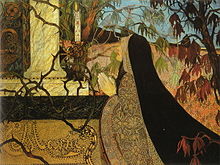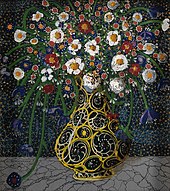Carl Strathmann

Carl Strathmann (born September 11, 1866 in Düsseldorf , † July 29, 1939 in Munich ) was a German painter and illustrator of Art Nouveau and Symbolism who worked in Munich .
Life
Strathmann grew up in Düsseldorf as the son of Carl Strathmann (* 1839 in Düsseldorf), a German wholesale merchant or manufacturer and later consul of Chile, in an upper-class family . His English mother Alice (* 1845 in Huddersfield ) enabled him to train as an artist. She must have drawn his gaze to English art as well. From 1882 to 1886 Strathmann studied at the Düsseldorf Art Academy , with Hugo Crola , Heinrich Lauenstein and, in particular, Adolf Schill . After he was dismissed there for “lack of talent”, Strathmann went to the art school in Weimar from 1886 to 1889 , where he was Leopold von Kalckreuth's master student in 1888/1889 .
Kalckreuth's departure prompted him to also leave Weimar and to move to Munich in 1891 to live as a freelance artist in its bohemia . In Munich he met the painter Lovis Corinth , with whom he had a lifelong friendship. There he created his large-format painting Salambo (1894/1895), a major work of Munich symbolism, which shows a scene from the novel of the same name by Gustave Flaubert : Salambo, the daughter of General Hamilkar , indulges in ritual caresses of a snake. Strathmann had inserted artificial gemstones into the ornamentally designed picture. The audience was horrified and accused him of “sadistic fantasy” and “monstrosity of representation”. The scandal suddenly made him known.
Around 1900 Strathmann had a joint studio with Alexander von Salzmann and Adelbert Niemeyer (Findlingstrasse 28 in Munich). He gained a reputation as a draftsman after Hanfstaengl published his portfolio of caricatures Fin de siècle . He drew for Pan and for the magazines Fliegende Blätter , Jugend and Simplicissimus, which were published in Munich . He also created patterns for wallpapers, menu cards, bookmarks, postcards and posters. He also designed his own furniture. He was known for his “peculiarly ornate, ornamental-craftsmanship stylized, Japanese-influenced ” painting style ( Thieme-Becker ), which took up motifs from the fin de siècle and techniques of pointillism and impressionism . His art, which shaped his penchant for the bizarre, ironic, eccentric and fantastic, is related to the paintings of Félicien Rops , Jan Toorop , Gustave Moreau and Franz Stuck .
Carl Strathmann was a member of the artists' associations Allotria and the Cocorello Club , the Munich Secession , which he soon left after disputes, the Free Association of the XXIV , the German Association of Artists and the Berlin Secession , which dedicated an exhibition to him in 1917. In 1904 Strathmann founded the Association of Munich Watercolor Artists together with Max Eduard Giese , René Reinicke , Hans Beat Wieland , Wilhelm Jakob Hertling, Hugo Kreyssig , Josua von Gietl , Rudolf Köselitz , Paul Leuteritz, Hans Gabriel Jentzsch , Fritz von Hellingrath and Karl Itschner . From 1912/1913 he was a member of the German Werkbund . Thomas Theodor Heine , Paul Neuenborn and Lovis Corinth were close friends. Corinth wrote that "Strathmann, in his ability to persist, immersed himself in the ornamental patterns of his pictures down to the smallest details and still tries to compose new motifs into the details."
Strathmann was buried in the forest cemetery in Munich . His artistic estate is in the Munich City Museum.
Works (selection)
- Salambo , oil and other materials on canvas (187.7 × 287 cm), 1894/1895, Klassik Stiftung Weimar
- Cranes of Ibycus , oil on canvas, burned in 1895, 1942, study on cardboard (80 × 58.5 cm) preserved, Neue Pinakothek
- Maria , oil on canvas (111.5 × 157 cm), around 1895, Klassik Stiftung Weimar
- Head of Medusa, around 1897, watercolor and ink on paper and cardboard (70 × 70 cm), Munich City Museum
- Idyll (Faun under an exotic tree blows the flute, winged cupids dance in their own way on a flowery meadow) , oil on cardboard (84 × 93.5 cm), 1913.
- Large golden vase (standing on a granite plate, filled with white flowers, water lilies, etc.) , oil on cardboard (97 × 68 cm), 1914.
- Snail mail (Cupid, blowing his horn, as a postilion on a snail) , oil on cardboard (49 × 49 cm), 1914.
- Storm attack , oil on canvas (200 × 247 cm), 1914, Münchner Stadtmuseum
- Funny musicians (in a winter landscape in the snow) , oil on cardboard (70.5 × 98.5 cm), 1916.
- Butterfly flowers (in a large gold, black and blue enameled vase on a mosaic-like background) , oil on cardboard (98 × 72 cm), 1916.
- Spring landscape with a stream , oil on cardboard (75 × 46 cm), 1917.
- Still life with flowers (black vase with meadow flowers) , oil on cardboard (49 × 34 cm)
- Book graphics : Aladin and the magic lamp (with drawings by Carl Strathmann). Anaconda Verlag, Cologne 2011, ISBN 978-3-86647-634-9 (original title: Das Märchenbuch. Fourth book. Alladin and the magic lamp . Bruno Cassirer Verlag, Berlin 1918, later edition 1922)
Exhibitions
Solo exhibitions
- 1902: Galerie Paul Cassirer , Berlin
- 1907: Arnold's Art Salon , Dresden
- 1910/1911: Galerie Paul Cassirer, Berlin
- 1911: Munich Art Association
- 1914: Kaiser Wilhelm Museum , Krefeld
- 1914/1915: Kunstvereine Frankfurt am Main , Augsburg , Leipzig
- 1916/1917: Berlin Secession (special exhibition)
- 1918: Kaiser Wilhelm Museum, Krefeld
- 1921: Leopold Hoesch Museum , Düren
- 1924: Vienna (special exhibition)
- 1931: Münchner Kunstverein (special exhibition)
- 1958: Galerie Wolfgang Gurlitt , Munich
- 1976: Rheinisches Landesmuseum Bonn
- 2019: Munich City Museum
Group exhibitions
- 1892: Fritz Gurlitt Gallery , Berlin
- 1893–1922: International Art Exhibition Munich (repeated participation), Munich Annual Exhibition, Munich Secession , Great Berlin Art Exhibition , Berlin Secession
- 1894: Fritz Gurlitt Gallery
- 1894/1895: Münchner Kunstverein (together with Walter Leistikow )
- 1895/1896: Kunsthalle Düsseldorf (special exhibition by the Laetitia artists' association )
- 1905: 2nd German Artists Association Exhibition , Berlin
- 1906: Kunstverein in Hamburg (Munich watercolorists)
- 1907: German National Art Exhibition , Düsseldorf
- 1958: House of Art , Munich (Munich 1869–1958. Departure to modern art)
literature
- Lovis Corinth : Carl Strathmann. In: Kunst und Künstler: illustrated monthly for fine arts and applied arts . Issue 1/1902, pp. 255 ff. ( Uni-heidelberg.de ).
- Walter Rothes: Carl Strathmann. In: Art for All . Volume 29, Issue 22, August 15, 1914, pp. 505-516 ( uni-heidelberg.de ).
- Ismar Lachmann: Karl Strathmann - Munich. In: German art and decoration: illustrated monthly issues for modern painting, sculpture, architecture, home art and artistic work by women. Koch, Stuttgart 1917, Volume 40, pp. 296-299 (with illustrations), ISSN 2195-6308 ( uni-heidelberg.de ).
- Carl Strathmann. In: Lovis Corinth: Legends from the artist's life. 2nd edition, Bruno Cassirer, Berlin 1918, pp. 68–82 ( zeno.org ).
- Johann Karl (Ed.): From Munich artist studios. Volume 5, self-published, Munich 1929, p. 8 ff.
- Strathmann, Carl . In: Hans Vollmer (Hrsg.): General lexicon of fine artists from antiquity to the present . Founded by Ulrich Thieme and Felix Becker . tape 32 : Stephens – Theodotos . EA Seemann, Leipzig 1938, p. 160 .
- Strathmann, Carl . In: Hans Vollmer (Hrsg.): General Lexicon of Fine Artists of the XX. Century. tape 6 , supplements H-Z . EA Seemann, Leipzig 1962, p. 436 .
- Joachim Heusinger von Waldegg : Grotesque Art Nouveau: Carl Strathmann 1866–1939: paintings, watercolors, drawings, prints . Rheinisches Landesmuseum Bonn. Commissioned by R. Habelt 1976, ISBN 3-7927-0271-1 .
- Nico Kirchberger (Ed.): Art Nouveau bizarre. Carl Strathmann. Exhibition catalog Münchner Stadtmuseum, Wienand, Cologne 2019, ISBN 978-3-86832-508-9 .
Web links
- Carl Strathmann , auction results on the portal artnet.de
- Blouinartinfo
- Carl Strathmann , biographical data in the portal kariko.de
Individual evidence
- ^ Friedrich Wilhelm Kantzenbach: Art handles. Client walks to Weltanschauung painting of the 19th / 20th centuries Century. Volume 1 (= writings on the international cultural and spiritual world. Volume 14). Dadder, 1994, p. 72 ff.
- ^ Walter Rothes: Carl Strathmann. In: Art for All. P. 505.
- ↑ Caress the serpent. LWL-Landesmuseum shows “scandalous painting”. Website ( lwl.org January 3, 2008, accessed November 21, 2015.
- ^ Walter Rothes: Carl Strathmann. In: Art for All. P. 506.
- ^ Walter Rothes: Carl Strathmann. In: Art for All. P. 514.
- ↑ Bettina Best: The history of the Munich Secession until 1938. A chronology. In: Jochen Meister (Ed.): Munich Secession: Past and Present. Prestel, Munich 2007, p. 17 ( zikg.eu PDF).
- ↑ kuenstlerbund.de: Full members of the Deutscher Künstlerbund since it was founded in 1903 / Strathmann, Carl ( Memento of the original from March 4, 2016 in the Internet Archive ) Info: The archive link has been inserted automatically and has not yet been checked. Please check the original and archive link according to the instructions and then remove this notice. (accessed on April 8, 2016)
- ↑ Miscellaneous - New Books. In: Art for All. Issue 19 of July 1, 1904, p. 460 ( uni-heidelberg.de ).
- ^ Horst Ludwig: Munich painter in the 19th century. Volume 4 Saffer – Zwengauer. Verlag Bruckmann, Munich 1983, ISBN 3-7654-1633-9 , p. 223.
- ↑ Grave of Carl Strathmann ( Memento of the original from November 21, 2015 in the Internet Archive ) Info: The archive link was inserted automatically and has not yet been checked. Please check the original and archive link according to the instructions and then remove this notice. , Website in the portal friedhof.stadt-muenchen.net , accessed on November 21, 2015.
- ↑ March 15 - September 22, 2019 Art Nouveau bizarre. Carl Strathmann. (No longer available online.) Archived from the original on May 31, 2019 ; accessed on August 10, 2020 .
- ↑ Salambo , image database in the portal akg-images.de , accessed on November 21, 2015.
- ^ Ibykus , Kunsthandel Lüder H. Niemeyer, accessed on September 16, 2016.
- ↑ Hugo Helbing (Ed.): Oil paintings by modern masters from North German private ownership: Auction in Munich at Galerie Helbing, May 22, 1917. Munich 1917, p. 9 (digitized version)
| personal data | |
|---|---|
| SURNAME | Strathmann, Carl |
| BRIEF DESCRIPTION | German painter |
| DATE OF BIRTH | September 11, 1866 |
| PLACE OF BIRTH | Dusseldorf |
| DATE OF DEATH | July 29, 1939 |
| Place of death | Munich |




